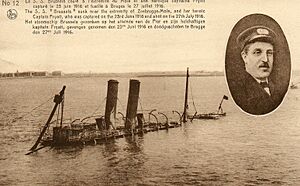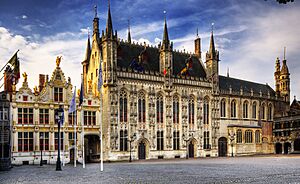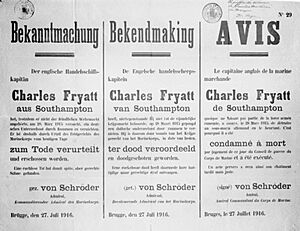Charles Fryatt facts for kids
Quick facts for kids
Charles Fryatt
|
|
|---|---|
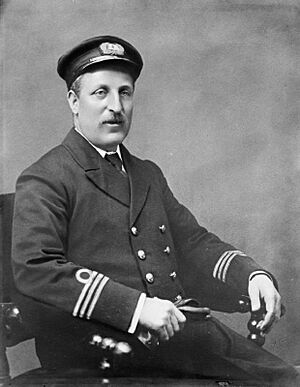 |
|
| Born |
Charles Algernon Fryatt
2 December 1872 Southampton, Hampshire, UK
|
| Died | 27 July 1916 (aged 43) Bruges, Belgium
|
| Cause of death | Execution by firing squad |
| Occupation | Merchant navy captain |
| Employer | Great Eastern Railway |
| Known for | Attempting to ram U-33 during the First World War and being executed for that act. |
| Spouse(s) | Ethel |
| Children | Olive, Victoria, Doris, Vera, Mabel, Charles, Dorothy |
| Awards | Order of Leopold (posthumous) Belgian Maritime War Cross (posthumous) |
Charles Algernon Fryatt (born December 2, 1872 – died July 27, 1916) was a brave British merchant ship captain during World War I. He became famous for trying to ram a German U-boat (a submarine) in 1915 to protect his ship.
Later, his ship, the SS Brussels, was captured by the Germans. Captain Fryatt was put on trial by the German military. He was found guilty of "illegal civilian warfare" because he was a civilian trying to fight back. He was then executed by a firing squad in Belgium. After the war, his body was brought back to the United Kingdom and reburied with special honors.
Contents
Early Life and Sea Adventures
Charles Fryatt was born in Southampton, England, on December 2, 1872. He went to school there and later in Harwich, Essex. He married Ethel, and they had seven children: six girls and one boy. His son, Charles, later followed in his father's footsteps and joined the merchant navy too.
After school, Fryatt joined the Merchant Navy. This is a fleet of civilian ships that carry goods and passengers around the world. He worked on several ships before joining the Great Eastern Railway in 1892. His father had also been a First Officer on one of their ships. Charles Fryatt worked his way up and eventually became a captain in 1913.
Facing U-boat Attacks
During World War I, German U-boats often attacked merchant ships. On March 3, 1915, Captain Fryatt's ship, the SS Wrexham, was chased by a German U-boat. Fryatt pushed his ship to its fastest speed, even getting his deckhands to help the stokers keep the engines going. The Wrexham escaped safely. For his courage, the Great Eastern Railway gave him a special gold watch.
Later that month, while he was captain of the SS Colchester, his ship was attacked again by a U-boat, but he managed to get away.
The Famous Ramming Attempt
On March 28, 1915, Captain Fryatt was commanding the SS Brussels. A German submarine, U-33, ordered his ship to stop. Fryatt saw that the U-boat was getting ready to torpedo his ship. Instead of stopping, he ordered full speed ahead and tried to ram the submarine! The U-33 quickly dived underwater to avoid being hit.
This brave action followed special orders from Winston Churchill, who was in charge of the British Navy at the time. These orders told merchant ship captains to fight back against U-boats, especially since Germany was sinking ships without warning. Captains were even told they could be punished if they surrendered their ships.
For this daring act, the British Navy gave Captain Fryatt another gold watch and a special certificate. He was also praised in the British Parliament.
Captured by the Enemy
On June 23, 1916, the Brussels was sailing from the Netherlands to England. Suddenly, five German destroyers surrounded the ship. The passengers were told to get ready to leave in lifeboats, and the ship's important papers were destroyed. The Germans captured the Brussels, broke its radio, and took it to Zeebrugge and then to Bruges in Belgium.
The Trial and Execution
Captain Fryatt and his crew were sent to a civilian prison camp in Germany. On July 16, 1916, news spread that Fryatt was accused of sinking a German submarine. However, the submarine he tried to ram, U-33, was actually still active. The Germans used the inscription on his gold watch from the British Navy as proof against him.
On July 27, 1916, Captain Fryatt was put on trial by the German Navy at Bruges Town Hall. He was found guilty of being a "franc-tireur" – which meant he was a civilian who fought like a soldier without being part of the official army. The Germans believed this was against the rules of war. He was sentenced to death, and the German Emperor himself approved the sentence.
At 7:00 PM that day, Captain Fryatt was executed by a naval firing squad in Bruges. He was buried in a small cemetery nearby.
An official notice was published in German, Dutch, and French, announcing Fryatt's death. It said that he was executed because he tried to destroy a German submarine, calling it a "ruthless deed" that had been "avenged."
After the War: German Review
After World War I, a German legal group reviewed Fryatt's case in 1919. They said that his execution did not break international law. However, they also said they were very sorry for how quickly the sentence was carried out. Not everyone in the group agreed; some believed his execution was a serious violation of international law and a "judicial murder."
Outrage and Support
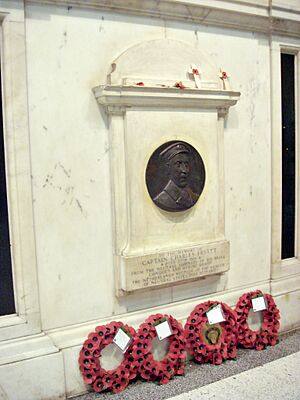
News of Captain Fryatt's execution caused great anger in Britain and other countries. On July 31, 1916, British Prime Minister H. H. Asquith said in Parliament that Fryatt had been "murdered by the Germans." He called it an "atrocious crime" and promised that those responsible would be brought to justice.
Many people spoke out against the execution. The Chairman of the Great Eastern Railway called it "sheer, brutal murder." Funds were started in Britain and the Netherlands to create a memorial for Fryatt. Newspapers in the United States, Netherlands, and Switzerland also strongly condemned the execution, calling it "deliberate murder" and "cowardly."
A memorial tablet was placed at Liverpool Street station in London exactly one year after his execution.
Captain Fryatt's family received much support. His wife was given a pension from the Great Eastern Railway and an extra pension from the government. The King of the United Kingdom, King George V, also wrote to Mrs. Fryatt, expressing his anger at the execution and praising Captain Fryatt's "noble instance of the resource and self-reliance" in defending his ship.
The story of Captain Fryatt even inspired an Australian film called The Murder of Captain Fryatt in 1917.
A Hero's Funeral
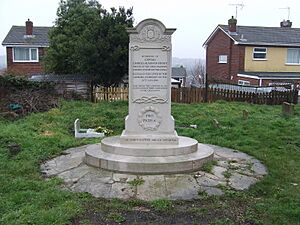
In 1919, after the war ended, Captain Fryatt's body was brought back to the United Kingdom for a special burial. He was one of only three British people given a state funeral after World War I. His coffin arrived in Dover and was taken to London.
On July 8, 1919, his funeral service was held at St Paul's Cathedral. Many merchant seamen, widows, and government officials attended. The band of the Great Eastern Railway played, and hymns were sung.
Captain Fryatt was buried at All Saints' Church in Upper Dovercourt. His coffin was carried to the church on a gun carriage. His widow received two awards given to Fryatt after his death: the Belgian Order of Leopold and the Belgian Maritime War Cross. In 2018, his grave was restored.
Remembering Captain Fryatt
Captain Fryatt is remembered in several ways:
- In Zeebrugge, Belgium, there is a street named after him: Kapitein Fryattstraat.
- A wing at a hospital in Dovercourt was named in his honor, and the hospital is now known as the Captain Fryatt Memorial Hospital.
- A public house (a type of pub) in Parkeston, Essex, is also named "Captain Fryatt."
- In Canada, a tall mountain called Mount Fryatt (11,027 feet or 3,361 meters high) was named after him in 1921. Another nearby mountain, Brussels Peak, was named after his ship.
Commemoration
In 2016, an exhibition was held in Harwich to mark 100 years since Captain Fryatt's execution. The local hospital in Harwich was officially renamed the Fryatt Memorial Hospital in his honor in 2019.
See also
- Baralong incidents - about British sailors firing on shipwrecked German U-boatmen
- Crash of Zeppelin LZ 54 (L 19) – about a German airship crew abandoned by the British to drown
- Thrasher incident


